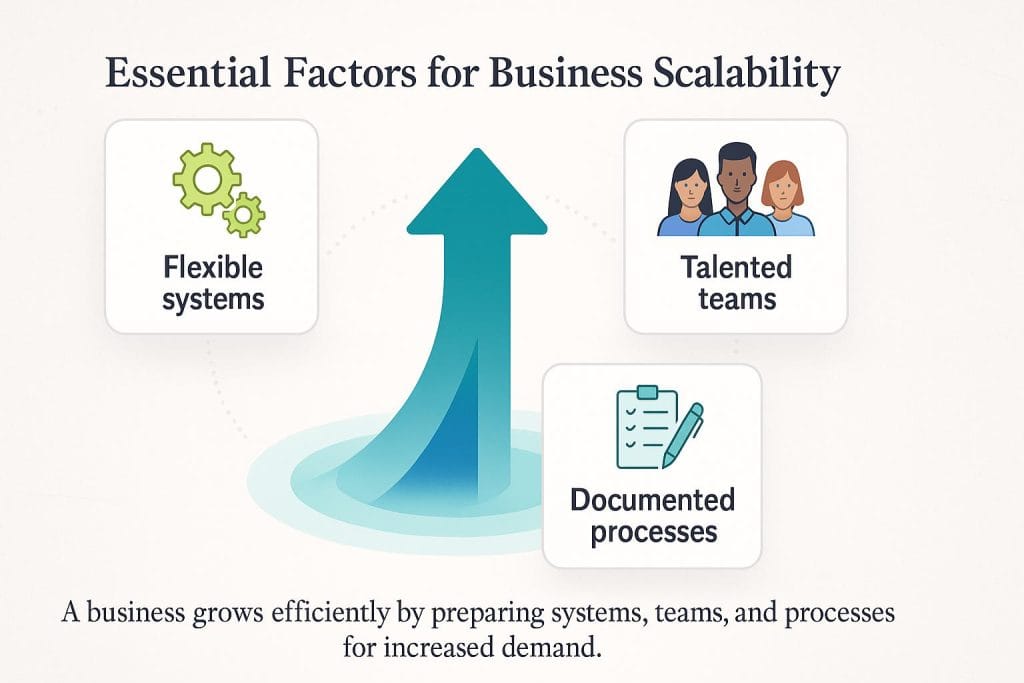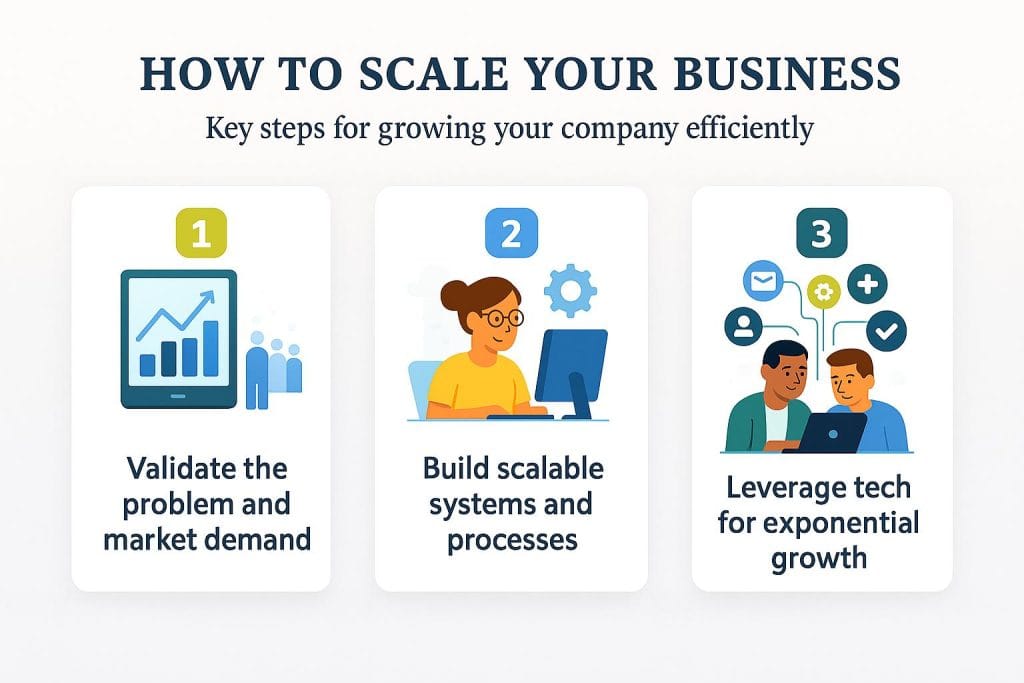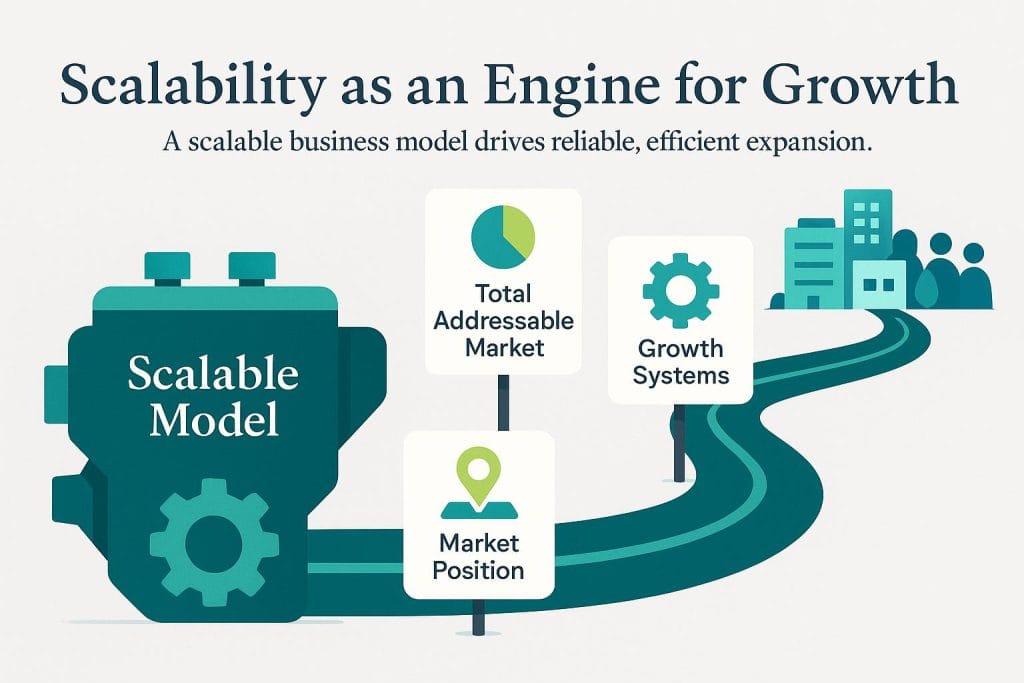Business.com aims to help business owners make informed decisions to support and grow their companies. We research and recommend products and services suitable for various business types, investing thousands of hours each year in this process.
As a business, we need to generate revenue to sustain our content. We have financial relationships with some companies we cover, earning commissions when readers purchase from our partners or share information about their needs. These relationships do not dictate our advice and recommendations. Our editorial team independently evaluates and recommends products and services based on their research and expertise. Learn more about our process and partners here.
Would You Make It on Shark Tank? The Importance of Scalable Business Models
If you're looking to grow your business, scalability should be your priority. Lay the foundation to boost your growth potential.

Table of Contents
If you’ve seen the television show Shark Tank, you know that the Sharks evaluate companies based on key factors like revenue growth, customer acquisition costs and scalability above all else.
Entrepreneurs with a growth mindset know that prioritizing scalability will help them create profitable businesses with a strong potential for longevity and success. To help you get started, we’ll share tips on scaling your organization and highlight the components of a scalable business model.
What is scalability in business?

Scalability in business refers to an organization’s ability to grow to meet increased demand. “[It] means having the ability to increase revenue without a proportional increase in costs,” explained Jen Stamulis, director of business development at Elasticity.
A scalable business doesn’t wilt in the face of an increasing workload. Instead, it continues to grow and boost efficiency by relying on the following core factors:
- Flexible systems: A scalable business typically has flexible systems that can withstand sudden and sustained growth over time.
- Talented teams: No one can scale a business alone, so scalable businesses usually have a strong team of employees with various skill sets who bring their talent and expertise to support growth.
- Documented processes: Scalable businesses have documented processes that others can replicate. A documented process makes it easier to train new employees and helps the company operate more efficiently.
“Ensuring scalability often means getting your systems, processes and business model prepared for growth from day one,” noted Niclas Schlopsna, managing consultant and CEO at spectup. “This includes standardized procedures, tech enablement and a focus on markets where demand can multiply without hitting resource bottlenecks.”
Why is scalability crucial for businesses?
Scalability is an important factor in a company’s success because it allows a business to grow and generate revenue without being held back by its structure or lack of resources. As a scalable company’s sales volume increases, it can maintain or boost its efficiency instead of imploding.
Here are a few reasons why building a scalable business is crucial:
- A scalable business can save you money: In some cases, scaling your business may require an upfront investment in systems, products or people. However, your initial investment in scalability can result in significant cost savings over the long run because it improves your company’s efficiency.
- A scalable business can boost revenue: Scaling allows your business to take on more customers and find additional revenue streams, resulting in increased revenue and a stronger overall business model.
- A scalable business creates a better customer experience: Scalable businesses have implemented processes and procedures that help them grow customer relationships by reducing wait times, offering superior products and services and providing efficient customer service. These tangible improvements enhance the customer experience and increase customer loyalty.
- A scalable business is flexible: The market can change quickly as customers’ interests and priorities shift, and a scalable business has the flexibility to adjust and meet changing market demands.
How to scale your business

Whether your business is in the startup phase or you want to make your current company more scalable, take the following steps.
1. Determine the market’s need for your products or services.
When considering scalability, you must first determine some essential factors about your business:
- Does your business solve a problem?
- What is the potential market for your product or service?
The answers to these questions often go hand in hand because if enough people experience a particular problem, many would likely benefit from your solution. When there are potential customers who will benefit from your offering, demand exists. You have a potentially robust target audience and can build your own market effectively.
Similarly, if a large enough market for a product or service already exists, there are likely inefficiencies in the quality or delivery of the product to customers. This creates opportunity.
You must identify your total addressable market because one key indicator investors look at is market size and a company’s ability to scale up or down in response to market variations.
2. Create systems to support your business as it grows.
Before scaling, you must create systems and processes to support your growing business. Without these systems and processes, your business may not be able to handle the increased demand that comes with growth.
Fortunately, technology has made it easier than ever to support a growing business. Consider the following systems:
- Automated data management: Data management is essential for growing businesses because it helps you understand the vast amount of customer, product and market data you’ll collect so you can make better decisions. Investigate the best customer relationship management (CRM) software for your needs. Make sure it works with one of the best accounting software solutions and, if applicable, the best point-of-sale systems. Gathering, organizing and analyzing all of this data is essential for scalability.
- Content marketing: Email marketing and social media marketing are effective and efficient ways to generate leads and tech tools can help you automate these processes. Evaluate the best email marketing services and digital marketing strategies to support your growing business.
- Cloud solutions: The cloud can help you grow your business and meet surging needs. For example, software-as-a-service offerings (including many top CRM systems) and cloud storage providers give you access to massive storage and computing power.
Creating systems to support scalability may require an upfront investment in time and money, but it will be worth it in the long run as you increase your capacity to handle business upsurges.
3. Identify what you can delegate and outsource.
No matter how talented they are, most entrepreneurs can’t do it all. They must learn to share responsibilities so their organizations aren’t bottlenecked or stunted. Set up crucial support by building a sales team, administrative department and customer service team to handle these specific functions. Empower your employees by delegating responsibilities and trusting them to make decisions. You’ll build a leadership team that frees you to focus on the high-level work needed to grow the company.
Some businesses may not be ready to hire but still need expert help. In this case, outsourcing can help you grow your business by offloading key functions to reputable partners. For example, consider outsourcing customer service to a call center or outsourcing HR functions to a professional employer organization or human resources outsourcing provider.
Components of a scalable business model
Every organization’s scalable business model is unique. It may involve a stand-alone product or service that can easily operate remotely or a model with a low barrier to entry. For example, a business like Uber can exist as long as customers need rides and people are willing to drive them.
No matter what your specific business is, a scalable business model should include these three components.
1. Standardization
All businesses benefit from the ability to get to market quickly. Creating a standardized process is vital to completing quality work efficiently and on time. Standardization also allows you to work with many partners or customers across different cities.
Marcus Lam, director of admissions and recruitment at The International School of Hospitality, emphasized the importance of standardized, repeatable processes. “To ensure scalability, I always start with repeatable processes. What can be taught? What can be automated? And most importantly, how can we keep the human touch while growing? That balance is key, especially in service industries.”
Hanna Adynets, founder of Adnsol LLC, noted that automation and standardization go hand in hand. “Automate everything you can and refine your model until it works like a Swiss watch — precise, reliable and adaptable to whatever comes your way,” Adynets advised. “Most importantly, don’t build something that’s dependent on you. Set it up so you’re working on scaling, not trapped in daily operations. Your focus should be strategic, not just keeping the machine running.”
2. Consistent management
People are your company’s biggest assets, and growing employees is key to business growth. Training and managing your team consistently is crucial because it makes it easier to move talented team members to areas of the business where they’re needed most. “You know you have a scalable business when you can step away and it still runs,” Lam noted.
Consider corporations with expansive franchise business models, like Dunkin’ and McDonald’s. The products and operations are remarkably consistent from one location to the next. If they have a superstar general manager, moving them to a location that’s struggling with revenue or profitability is relatively seamless. (It’s also important to monitor product quality across locations to maintain consistency and track improvement.)
Enterprise Rent-A-Car is another example. Its products and services are the same regardless of location, and the company is known for moving team members to different branches as part of its management training program. As a result, these businesses can easily open stores in new markets — the essence of scalability.
3. Use of existing assets
A business model that effectively leverages existing assets will likely get your business into new markets sooner than a model that requires everything to be built from scratch.
Airbnb is an excellent example. Rather than building places for people to stay while traveling, the company utilizes assets that members already own. The platform works whether it’s a loft in New York, a house in London or an apartment in Tokyo.
Examples of businesses that demonstrated scalability
Companies across various industries have experienced the benefits of scalability. Here are four examples to consider:
- Shopify: Shopify is best known as an e-commerce platform, but it has expanded into payment processing, marketing and shipping services. By scaling, Shopify can support businesses of all sizes.
- Zoom: Zoom’s profile soared in 2020 as the pandemic forced many employees to work from home and video conferencing became essential. Because of its virtual nature, Zoom met increased demand instantly and scaled quickly.
- DoorDash: The DoorDash business model allows it to scale up or down as needed to meet demand. Uber Eats and Grubhub operate similarly, adjusting their capacity to match changing market conditions.
- Spotify: Spotify and its competitors typically use a “freemium” model that allows users to upgrade to an enhanced paid plan at any time. Many users who enjoy the service eventually convert to paying subscribers. Spotify’s digital infrastructure enables it to scale as needed.
Scalability as an engine for growth

A scalable business model serves as an engine of growth for your company and positions it well to handle that growth with the proper systems in place. Importantly, growth potential and scalability are two significant factors in a business’s valuation.
Once you’ve considered your market position and total addressable market, you can begin implementing systems and processes that lay the foundation for a company built to grow.
Jennifer Dublino contributed to this article.







